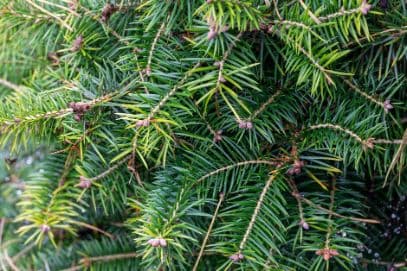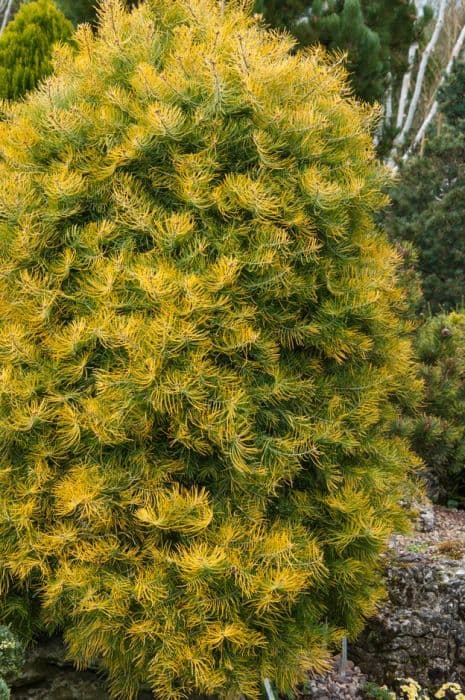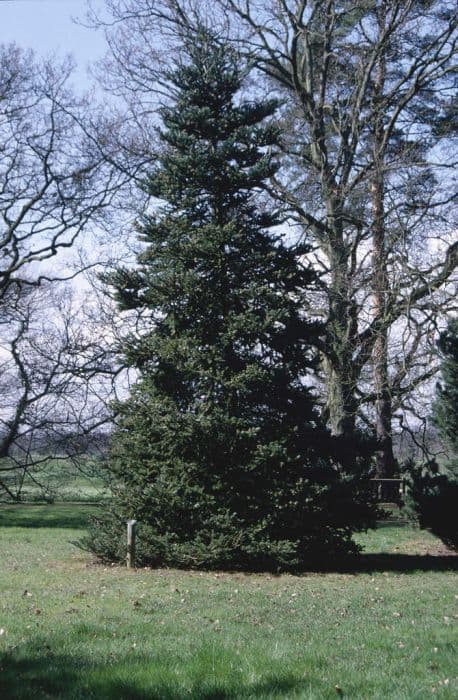Black Pine Pinus nigra 'Moseri'

ABOUT
Pinus nigra 'Moseri', commonly known as the Black Pine 'Moseri', presents a visually striking figure, bringing character to any landscape. This particular evergreen conifer is characterized by a dense, compact shape, holding its branches in a well-formed, symmetrical pattern that makes it a favorite among gardeners for its consistency in appearance. The needles of the Black Pine 'Moseri' are a deep green, giving it a lush appearance throughout the year. They are typically stiff and long, radiating out from the branches to create a full, robust look. These needles contribute to the overall rich texture of the plant as they cluster together. As for the cones, they are conspicuous and add to the decorative nature of this pine. The attractive cones generally start out a more subtle color before maturing to a woody brown as they age and dry. They sit among the needles and can persist on the tree, adding interest even in the dormant seasons. The bark of the Black Pine 'Moseri' is rugged and provides a textural contrast to the softness of the needles. It tends to be deeply grooved and has a color that may vary from gray to a nearly black hue, which helps in defining the 'black' in its common name. Overall, the Black Pine 'Moseri' exhibits an aesthetic that combines structured form with the picturesque charm of evergreen foliage, complemented by the mature cones and the tree's textured bark. It stands out with its perpetual verdancy and conical shape, making it a beloved choice for those looking to add a touch of evergreen elegance to their surroundings.
About this plant
 Names
NamesFamily
Pinaceae
Synonyms
Black Pine, Austrian Pine, European Black Pine
Common names
Pinus nigra 'Moseri'.
 Toxicity
ToxicityTo humans
The plant in question is the Austrian pine. In general, the Austrian pine is not considered toxic to humans. However, ingesting any part of the plant is not advisable as it is not meant for consumption. If large quantities of needles or other plant parts are ingested, they may cause a mechanical obstruction or irritation in the digestive tract, potentially leading to symptoms such as gastrointestinal discomfort or blockages.
To pets
The Austrian pine is also not known to be toxic to pets. However, similar to humans, ingestion of a significant amount of plant material, such as needles, can potentially lead to gastrointestinal upset or obstruction. Watch for symptoms such as vomiting, diarrhea, or changes in behavior, and consult with a veterinarian if any concerning signs arise after your pet has ingested parts of this plant.
 Characteristics
CharacteristicsLife cycle
Perennials
Foliage type
Evergreen
Color of leaves
Green
Height
20-30 feet [6-9 meters]
Spread
10-20 feet [3-6 meters]
Plant type
Tree
Hardiness zones
4-7
Native area
Europe
Benefits
 General Benefits
General Benefits- Ornamental Value: The Pinus nigra 'Moseri', commonly known as the Black Pine, is highly valued for its aesthetic appeal in landscapes and gardens due to its distinctive shape and rich, dark green foliage.
- Durability: Black Pine is known for its toughness, making it a suitable choice for urban environments and harsh climates.
- Erosion Control: Its extensive root system helps stabilize the soil, preventing erosion on slopes and banks.
- Wildlife Habitat: Provides shelter and nesting sites for birds, as well as sustenance from its seeds for wildlife.
- Shade and Windbreak: The dense foliage offers excellent shade in summer and can act as a windbreak, reducing wind speed and protecting nearby areas.
- Privacy Screen: It can be planted in rows to create a natural, evergreen screen for privacy.
- Low Maintenance: Once established, Black Pine requires minimal care, making it an ideal plant for those looking for low-maintenance landscaping options.
- Year-Round Interest: Being an evergreen conifer, it retains its needles all year, providing constant visual interest even in winter months when other plants lose their leaves.
- Drought Tolerance: After establishment, Black Pine is fairly drought-tolerant, needing less frequent watering than many other tree species.
 Medical Properties
Medical PropertiesThis plant is not used for medical purposes.
 Air-purifying Qualities
Air-purifying QualitiesThis plant is not specifically known for air purifying qualities.
 Other Uses
Other Uses- Woodworking: The wood of the Austrian Pine is often used for rustic furniture making and wood carving due to its workability and aesthetic texture.
- Sound Barriers: These pines can be planted in rows to act as a natural sound barrier due to their dense growth habit and foliage, reducing noise pollution in suburban areas.
- Soil Stabilization: Because of their extensive root system, Austrian Pines are planted on slopes or areas prone to erosion to help stabilize the soil.
- Windbreaks: The species is often used in windbreak plantings in rural areas to protect soil and crops from wind damage.
- Bonsai: Some enthusiasts use Austrian Pine for creating bonsai trees due to its resilience and adaptability to pruning.
- Privacy Screens: The dense foliage and the ability to endure harsh trimming make it a popular choice for hedges and privacy screens in gardens.
- Shipbuilding: Historically, timber from the Austrian Pine has been used in shipbuilding, particularly for masts due to its tall and straight growth.
- Festive Decor: Branches of the Austrian Pine are sometimes cut and used for making holiday wreaths and other festive decorations.
- Pine Straw Mulch: The fallen needles, known as pine straw, can be collected and used as an acidic mulch for garden beds.
- Photography: The picturesque quality of the Austrian Pine makes it a favored subject for landscape photography.
Interesting Facts
 Feng Shui
Feng ShuiThe Austrian Pine is not used in Feng Shui practice.
 Zodiac Sign Compitability
Zodiac Sign CompitabilityThe Austrian Pine is not used in astrology practice.
 Plant Symbolism
Plant Symbolism- Longevity: The European black pine can live for hundreds of years, symbolizing endurance and the passage of time.
- Resilience: This species is known for its ability to withstand harsh conditions, representing strength and the ability to persist through adversity.
- Stability: With its deep roots and sturdy trunk, the European black pine is often associated with groundedness and support.
- Peace: Pine trees in general are seen as emblematic of serenity and tranquility, offering a sense of calm and repose.
- Wisdom: The long lifespan and evergreen nature of pines are seen as symbols of ancient knowledge and eternal truths.
 Water
WaterThe Austrian Pine (Pinus nigra 'Moseri') should be watered deeply every two to three weeks during its first growing season to establish an extensive root system. Once established, it's drought-tolerant and typically requires watering once a month during dry periods. When watering, provide the tree with about 10 to 15 gallons of water, ensuring it reaches the roots without causing waterlogging. In hot summer climates, increase watering frequency to every two weeks. Avoid over-watering, as this pine prefers drier conditions.
 Light
LightAustrian Pine prefers full sun exposure, meaning it should receive at least 6 hours of direct, unfiltered sunlight each day. The best spot for planting this pine is an open area away from large buildings or other trees that could cast shade, as ample sunlight supports healthy growth and needle development.
 Temperature
TemperatureAustrian Pines are hardy and can withstand a range of temperatures, often surviving winter lows down to -20°F and thriving in summer temperatures up to 90°F. Ideally, they prefer climates where typical temperatures range from 30°F to 70°F. They are suited for USDA hardiness zones 4 through 7, indicating their resilience to cold.
 Pruning
PruningPruning the Austrian Pine can help maintain its shape and remove any dead or damaged branches. It's best to prune in late winter or early spring before new growth begins. Generally, prune sparingly and only as needed to remove dead or diseased wood or to correct growth problems. Avoid heavy trimming, as this can harm the tree.
 Cleaning
CleaningNot needed
 Soil
SoilThe Austrian Pine 'Moseri' prefers well-drained soil with a mixture of loam, sand, and organic matter to aid drainage and fertility. A slightly acidic to neutral pH, about 5.5 to 7.0, is optimal for this plant.
 Repotting
RepottingAustrian Pine 'Moseri' is typically slow-growing and does not need frequent repotting. It may require repotting every 2 to 4 years, more commonly as it is young or if growth indicates it has become root-bound.
 Humidity & Misting
Humidity & MistingAustrian Pine 'Moseri' tolerates a wide range of humidity levels and is well-suited for outdoor conditions. It does not require specific humidity adjustments when grown in its natural outdoor environment.
 Suitable locations
Suitable locationsIndoor
Position near a sunny window, ensure good ventilation, rare watering.
Outdoor
Plant in full sun, protect from strong winds, well-drained soil.
Hardiness zone
4-7 USDA
 Life cycle
Life cyclePinus nigra 'Moseri', commonly known as the 'Moseri' Black Pine, begins with seed germination after stratification, which simulates winter conditions to overcome dormancy. The young seedling develops a root system and grows into a sapling, which subsequently matures into an adult tree with a distinctive conical shape. As the Black Pine matures, it produces cones; male cones release pollen, which is carried by the wind to fertilize the female cones. The fertilized female cones develop seeds over time, which are eventually dispersed by wind or animals. After reaching maturity, which may take several years, the Black Pine can live for many decades, during which it will continue to grow and produce cones annually. Old age will ultimately lead to a decline in vigor, with the tree eventually succumbing to environmental stress, disease, or natural death.
 Propogation
PropogationPropogation time
Spring to Summer
The Austrian Pine, scientifically known as Pinus nigra 'Moseri', is most commonly propagated through seed sowing. To achieve this, seeds must be collected from the pine cones when they are ripe, which typically occurs in autumn. It is important that the seeds are then stratified, which means they need to be subjected to a period of cold to break dormancy; this can be done by mixing them with slightly moist sand and storing them in the refrigerator for about 1 to 2 months. Following stratification, the seeds can be sown in well-draining soil under full sunlight. It's best to plant them at a shallow depth of about a quarter inch (approximately 6 millimeters) and keep the soil consistently moist until germination, which generally takes a few weeks to a couple of months depending on conditions.









